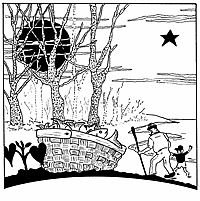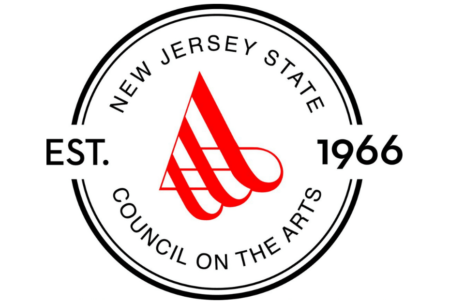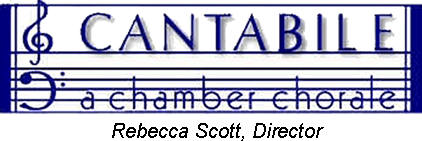 We dedicate this program to Leila Eutermarks, remembering her gifts to us: kindness, courage, music, laughter.
We dedicate this program to Leila Eutermarks, remembering her gifts to us: kindness, courage, music, laughter.
Spring makes its entrance fitfully, teasing all the senses rather than declaring the new season with a fanfare. A shift in the breeze, dancing light on distant waves, fresh green smells, a buzz barely heard at first, ever-brighter days… We stare into the Dazzle of Day, and light seems to shimmer downward, filling our senses to overflowing. The great Chilean poet Pablo Neruda, at his hilltop villa “Isla Negra” overlooking the Pacific, wrote: “I open my heart … from my glass I drink / pure joy.” Composer Edie Hill’s impressionist sound-painting builds gradually, voices joining one by one in augmented rising scales breathing in the new air, over a thrumming guitar suggesting new birth, until all “join in … a huge, wordless expression of joy.”
Beyond the shimmer of a spring day, points of light dance within infinite darkness. Aviator-poet Antoine de Saint-Exupéry knew the stars as beacons and friends, perhaps as ultimate destination, as in the gripping account Night Flight. Before his own disappearance on a reconnaissance mission in 1944, St-Exupéry left behind a simple fable illustrated with unforgettable sketches of his alter ego, the Little Prince, who appeared to him in mid-Sahara after a near-fatal crash landing. The Little Prince lives today, around the world, in sixty languages, reminding us how unimportant are ”big” things compared to one rose on a single tiny distant planet. This was a favorite text for Leila and her family. Cantabile is honored to have commissioned a setting of the closing passages. The Prince consoles his friend before departing life on this planet for his distant home: “In one of the stars I will be laughing.” We thank Emma Lou Diemer for a loving setting that keeps the simplicity and wisdom of the fable.
To mark the 250th anniversary of Mozart’s birth, we open with a selection of brief works spanning his short life, displaying his amazing gift for setting himself challenges. These include the English-language anthem God is our refuge (composed as a gift to the British Museum when he was eight years old!) and the beloved motet Ave Verum Corpus, composed in his last year after he had immersed himself in study of Bach’s b minor Mass. The secular canons range from the aria-like love song Caro bell’ idol (Never forget me, my beauty) and the laments Lacrimoso (Full of tears) andNascoso (My sun has sunk, I die here alone) to a triple-canon chorale that delivers both messages at once: V’amo di core / Io non vi posso / Uh, che dolore (I love you with all my heart / I can’t help it / What torment). Two sacred canons, both from his 15th year, form a study in contrasts. Kyrie is a chain of 5-part canons for equal sopranos, matching the three sections of text. Dona Nobis Pacem, simple and moving, could be a congregational benediction.
Our program title CELESTIAL SPRING, which suits exactly the Neruda and St.-Exupéry texts, actually comes from the featured work by Bruce Lazarus, commissioned for Cantabile by director Rebecca Scott. Lazarus writes:
Thank you very much for the fine performance of Celestial Winter last year. I am thrilled you will now perform the sequel, Celestial Spring, next month. The four choral songs which comprise Celestial Spring were composed between 2003 and December 2005.
Camelopardalis, the celestial giraffe, is a faint constellation near the Big Dipper, best seen in spring and summer. The music imitates the peculiar slow-motion, long-legged gait of this “ballerina of the sky.” After a lifetime of collaboration with the ballet and modern dance world, I feel I have a right to this affectionate personification.
Anicius Manlius Severinus Boethius, 5th century Italian philosopher, wrote extensively on the relation of music to science, suggesting that stars and planets in their regular courses generate musical pitches. The short, repeated phrases are not intended to be minimal, but rather performed with a crescendo and a general increase of energy – there is always a destination.
Aurora Borealis was composed on request by Rebecca Scott. I spent much of summer 2004 studying the science behind this beautiful phenomenon. But my preliminary sketches ended up in the wastepaper basket. Finally, during the hottest days of August, seeing how frustrated I had become, Mary Fleischer asked, “why are you trying to express the inexpressible in words?” At that moment, the Aurora piece was born. There would be no text, no words, no definite shapes — only colors, sounds, and variated repetition without beginning or end.
While “Aurora” could stand alone, it did not make a satisfying conclusion to a short group of pieces. Fanciful descriptions of Clouds, with meteorological labels, set to an easy-going rock shuffle, provide a needed cheerful ending.
A rainbow is both star and cloud: the sun’s light refracted from an arch of water droplets. A rainbow, not the rainbow — the one you see follows your eyes, and dances from different droplets than does myrainbow, but both of course are born in a shared sun, like our personal memories of a common friend.And its glorious spectrum testifies to two hidden truths: white light is not pure, but a mixture of fiery hues, and water responds differently to each hue. Inspiration even to the scientific mind. “Grandpa and the Rainbow,” El abuelo y el Arcoiris, is a double memorial. Costa Rican poet Jorge Charpentier cherishes a private memory of his departed grandfather: a curious boy asks the silent man what he sees in the distant sky. The choral setting by David V. Montoya is a memorial to Charpentier, commissioned by William Wells Belan, Cal State Los Angeles, as a gift to Costa Rican conductor David Ramiriz and El Café Chorale.
Fittingly, children’s voices are heard in the dialog with Grandpa. These young singers have been rehearsing for several weeks with Ms. Scott and members of Cantabile. They join us also for Cucú, a comical Spanish nursery rhyme for two-part chorus, two adult voices, and guitar, from Four Spanish Lullabies by Francisco Nuñez. Nuñez conducts the superb New York Children’s Chorus — hear a concert live or on WNYC.
Nothing childish about young Cassandra, resisting the pressure of society, in the 15c. Spanish play by Gil Vicente.. David Montoya captures her dilemma as a classic ABA song for women’s trio. To herself, “They say I should marry (Dicen que me case yo) but I don’t want to.” Then, to her mother, defiantly: “This flower won’t marry and waste her God-given gifts.” Losing heart: “…but they say I must.” Again to herself: “No man yet born is worthy to be my husband.” Despite ominous tapping of finger cymbals, alternately sounding like castanets, a dropped tear, or a chapel bell, she finally plucks up her courage, strumming the guitar: “I won’t be married — NO!” How does this age-old drama play out? For one ending, c.1936, see Repertorio Español tomorrow in New Brunswick, staging La casa de Bernarda Alba by the great poet-playwright-composer Federico Garcia Lorca.
For millennia, sung-poetry has been accompanied by guitar or zither. Many works on our program continue this tradition, providing a chance to collaborate with renowned New Jersey-based classical guitarist Christopher Kenniff. He has agreed to perform a group of solos as well, from Castles of Spain by Federico Moreno-Torroba: Turegano is subtitled Serranilla, a lyric composition, in Rondo form. Torija is an Elegia, musical poetic remembrance of one deceased. Alcaniz is a merry Festiva.
The Spanish / Caribbean theme continues as we close with two favorites from earlier programs, the Papiemento harvest song Balia di Sehú and the Costa Rican wedding song Caña Dulce.
***




 We dedicate this program to Leila Eutermarks, remembering her gifts to us: kindness, courage, music, laughter.
We dedicate this program to Leila Eutermarks, remembering her gifts to us: kindness, courage, music, laughter.